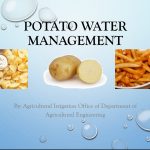
Title of document: Potato Water Management Authors: Agricultural Irrigation Office of Department of Agricultural Engineering Journal’s name if any: Ministry/Government Agency/Organisation: MAFF Year of publication: 2018 Geographic focus: Cambodia Main issues / topics addressed (for example: Climate requirement; Seasonal water requirements; Soil requirements; Irrigation management; Potato growth and irrigation scheduling……) School of agroecology (if any): Web address to original document (if any): Summary: This presentation for Dissemination Workshop on the Potato Varieties Testing for the Production in Cambodia, 29 March 2018 Read More
10 downloads
Author: ALiSEA teams
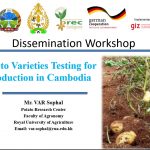
Title of document: Potato Varieties Testing for Production in Cambodia Authors: Mr. VAR Sophal Journal’s name if any: Ministry/Government Agency/Organisation: MAFF, RUA, PREC, GIZ Year of publication: 2018 Geographic focus: Cambodia Main issues / topics addressed (for example: Introduction; Objective; Methods; Result; Lesson Learnt……) School of agroecology (if any): Web address to original document (if any): Summary: This presentation for Dissemination Workshop on the Potato Varieties Testing for the Production in Cambodia, 29 March 2018 Read More
17 downloads
Author: ALiSEA teams
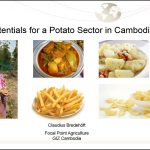
Title of document: Potentials for a Potato Sector in Cambodia Authors: Claudius Bredehöft Journal’s name if any: Ministry/Government Agency/Organisation: GIZ Year of publication: 2018 Geographic focus: Cambodia Main issues / topics addressed (for example: Nutritional Value; Economic Analysis; Challenges for the potato supply chain to overcome; Opportunities……) School of agroecology (if any): Web address to original document (if any): Summary: This presentation for Dissemination Workshop on the Potato Varieties Testing for the Production in Cambodia, 29 March 2018 Read More
9 downloads
Author: ALiSEA teams
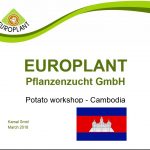
Title of document: EUROPLANT: Pflanzenzucht GmbH Authors: Kamal Smid Journal’s name if any: Ministry/Government Agency/Organisation: EUROPLANT Year of publication: 2018 Geographic focus: Cambodia Main issues / topics addressed (for example: Europlant company structure; Potato market in South East Asia; Europlant varieties for Cambodia; Cultivation of potatoes ……) School of agroecology (if any): Web address to original document (if any): Summary: This presentation for Dissemination Workshop on the Potato Varieties Testing for the Production in Cambodia, 29 March 2018 Read More
10 downloads
Author: ALiSEA teams
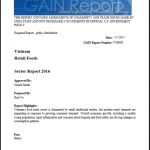
Title of document: Vietnam Retail Foods Authors: Gerald Smith and Kiet Vo Journal’s name if any: Ministry/Government Agency/Organisation: USDA/FAS Year of publication: 2017 Geographic focus: Vietnam Main issues / topics addressed (for example: Market Summary; Road map for market entry; Competition; Best Product Prospects ……) School of agroecology (if any): Web address to original document (if any): Summary: Vietnam's food retail sector is dominated by small traditional traders, but modern retail channels are expanding in response to growing consumer demand. Overall economic growth, including a sizable young population, rapid urbanization and concerns about hygiene and food safety are driving changes in consumption patterns. Read More
6 downloads
Author: ALiSEA teams
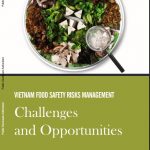
Title of document: Vietnam Food Safety Risks Management “Challenges and Opportunities” Authors: WB Group Journal’s name if any: Ministry/Government Agency/Organisation: WB Group Year of publication: 2017 Geographic focus: Vietnam Main issues / topics addressed (for example: Institutional setup and capacity for food safety management; Key pork and vegetable value chains in Ha Noi and Ho Chi Minh City; Food safety hazards, risk and health impact……) School of agroecology (if any): Web address to original document (if any): Summary: In Vietnam, food safety is of great and increasing importance to consumers and policymakers alike. The Government of Vietnam requested the World Bank and other development partners for assistance in assessing food safety risks and in providing policy recommendations on how to improve food safety risk management. To this end, a series of activities, including a literature review, field visits, round-table discussions and interviews with experts and consultations were held between January and July 2016. While food safety was broadly addressed, the emphasis of this review was on domestic urban markets with a special focus on pork and leafy vegetable value chains supplying Ha Noi and Ho Chi Minh City. This report presents the key findings to help identify priorities and practical solutions to address food safety. Read More
20 downloads
Author: ALiSEA teams
Title of document: PGS Organic Standards Authors: MARD Journal’s name if any: Ministry/Government Agency/Organisation: MARD Year of publication: 2012 Geographic focus: Vietnam Main issues / topics addressed (for example: General Farm Management; Organic Crop Production; Organic Animal Husbandry; Processing and Handling……) School of agroecology (if any): Web address to original document (if any): Summary: The Vietnam PGS Organic Standards for Producers are standards drafted by the PGS Coordination Committee in line with IFOAM Basic Standards and MARD’s Standards for Organic Production and Processing. These PGS Standards for Producers cover crop production as well as animal production. Separate Standards are developed for handling, processing, and retailing. Together, these standards enable the Vietnam PGS to give certification service for organic crops and animals produced from farm up to the final sale to consumers. Read More
14 downloads
Author: ALiSEA teams
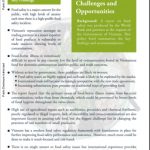
Title of document: Vietnam Food Safety Risks Management Authors: WB Group Journal’s name if any: Ministry/Government Agency/Organisation: WB Year of publication: Geographic focus: Vietnam Main issues / topics addressed (for example: Principles for a high performing food safety systems; Key policy recommendations……) School of agroecology (if any): Web address to original document (if any): Summary: A report on food safety was produced by the World Bank and partner at the request of government of Vietnam. This policy brief summaries the key finding and recommendation. Read More
7 downloads
Author: ALiSEA teams
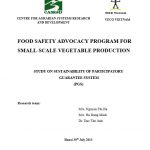
Title of document: Food Safety Advocacy Program for Small-Scale Vegetable Production: Study on Sustainability of Participatory Guarantee System (PGS) Authors: MA. Nguyen Thi Ha; MA. Ha Dung Minh; Dr. Dao The Anh Journal’s name if any: Ministry/Government Agency/Organisation: CASRD; VECO VIETNAM Year of publication: 2013 Geographic focus: Vietnam Main issues / topics addressed (for example: Methodologies; Limitations of The Study; Research Results; Conclusions and Recommendations……) School of agroecology (if any): Web address to original document (if any): Summary: The study focuses on suitability of the PGS structure and organization for Vietnam where smallholder farmers account for 80 percent of agricultural producers. The manner of PGS organization is suitable for the conditions of production in Vietnam. During the production process under PGS, the farming households have been provided production knowledge, inspection skill and continuously strengthened capacity to operationalize PGS as quality control system for vegetable production Read More
16 downloads
Author: ALiSEA teams
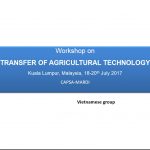
Title of document: Vietnamese group: Workshop on Transfer of Agricultural Technology Kuala Lumpur, Malaysia, 18-20th July 2017 Authors: Vietnamese group Journal’s name if any: Ministry/Government Agency/Organisation: Year of publication: 2017 Geographic focus: Vietnam Main issues / topics addressed (for example: Development of agricultural sector in Vietnam; Application of ICT in Vietnam’s agriculture; The challenges for agricultural development in Vietnam……) School of agroecology (if any): Web address to original document (if any): Summary: The presentation for CAPSA-MARDI Regional Training Workshop on Transfer of Agricultural Technology with Specific Focus on “Application of ICT for Resilient Agriculture”, 18 - 20 July, 2017, Putrajaya, Malaysia Read More
3 downloads
Author: ALiSEA teams

 Asia & Mekong Region
Asia & Mekong Region  Cambodia
Cambodia  Laos
Laos  Myanmar
Myanmar  Other
Other  Vietnam
Vietnam